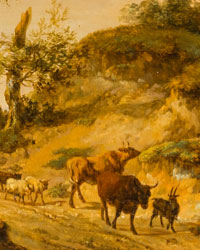No. 95833955

Jack Friling (1927-2000) - Wayfarers
No. 95833955

Jack Friling (1927-2000) - Wayfarers
Jack Friling (Drammen, Norway, 1927 - Firenze, Italy, 2000), Wayfarers, mixed media on paper, 1957.
The painting depicts two figures wrapped in long robes, barely hinted at in profile, facing each other on the edge of a body of water rendered by thick horizontal lines. Above, a crescent quarter moon illuminates a landscape of broken rocks and fissures;. The atmosphere is nocturnal, suspended, almost mystical, and the whole composition plays on the alternation of solid masses and calligraphic marks.
Friling works with three main tones-deep black, a warm ochre spread in compact backgrounds, and touches of white-that build a strong interplay of solids and voids.
Friling's poetics revolve around the great themes of man and nature, treated with "simplified figurative forms," "powerful color backgrounds," and dense symbolism (sun, moon, circle, bird, horse) that alludes to the soul's tension toward light and hope. The work analyzed here shows in nuce precisely these characteristics: the use of the moon as a cosmic emblem, the white creating sudden flashes, the centrality of isolated figures caught in a moment of emotional suspension.
Signed by hand in the lower right corner.
In very good condition.
The sheet size is 60 x 46 cm; with the frame, considered a seller's gift, the dimensions are 69 x 54 cm.
Jack Friling, born in Drammen on October 24, 1927, had his first artistic training in his homeland: between 1946 and 1948 he attended the atelier of painter Bjarne Engebret in Oslo and, from 1949 to 1952, the Statens Kunstakademi under the guidance of expressionist Per Krohg; in the meantime he made short study sojourns in England, France and Spain, refining a language that was already distinctly symbolic and visionary.
In 1953 he decided to settle in Italy, in Florence, the city with which he would forever intertwine his destiny. Here he graduated from the Accademia di Belle Arti (teacher Ottone Rosai) and the Istituto Nazionale per l'Artigianato Artistico; only a year later he made his debut with a solo exhibition at the Galleria Numero, arousing the interest of critics for the archaic force of his canvases and monotypes. At the turn of 1957-1959 he won three gold medals at the National Painting Awards in Viareggio, the "Golden Lily" in Florence, and other awards that imposed him on the Italian and northern European scene.
The 1960s and 1970s are marked by frenetic exhibition activity: solo shows in Boston, New York, Munich, Amsterdam, Delft, Pompeii, extensive tours of the Netherlands and Scandinavia, invited lectures at the University of the South (Sewanee) and the Academy of Fine Art in Atlanta, entry (1959) into the Historical Archives of the Venice Biennale and the awarding of honorary citizenship of Gubbio (1959) and Pompeii (1979). In 1969-73 he resided in the Netherlands, then again in Norway and Scotland, while maintaining Florence as his creative center of gravity.
Stylistically, Friling fuses Nordic expressionism with Tuscan tradition: simplified figures, mighty backgrounds of ochre, black and white "in reserve," a scratched mark that digs into the matrix like a blade of light. Recurring incessantly are cosmic symbols - sun, moon, circle - and images of passage (birds, horses, swirls of water) that allude to human drama and hope. The artist calls himself a "realist and mystic": his compositions oscillate from dramatic tone to lyrical chord, but always with the aim of showing "the higen and dragning mot lyset," the tension toward light.
In 1980 he completed a vast cycle of illustrations for the Divine Comedy, the culmination of an interest in Dante germinated from his early days; during the same period he alternated his Florentine studio with a retreat in Panicaglia, a small Tuscan village where the inhabitants nicknamed him "the Professor" and remembered his eccentrically wrapped figure in coat, boots and hat in every season.
Friling continued to exhibit, engrave woodcuts and produce large oilsuntil his death in Florence on Jan. 8, 2000; his remains were then transferred to Norway, ideally closing the link between the two homelands that had nurtured his imagination.
You might also like
-
-
-
-
-
-
-
-
-
-
This object was featured in
How to buy on Catawiki
1. Discover something special
2. Place the top bid
3. Make a secure payment

